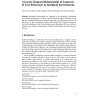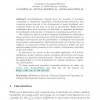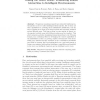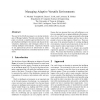168
Voted
CONTEXT
2011
Springer
14 years 7 days ago
2011
Springer
Pervasive computing envisions implicit interaction between people and their intelligent environments instead of individual devices, inevitably leading to groups of individuals inte...
88
Voted
ISAMI
2010
14 years 10 months ago
2010
Intelligent Environments are supposed to act proactively anticipating user's needs and preferences in order to provide effective support. Therefore, learning user's frequ...
136
click to vote
UIC
2010
Springer
14 years 10 months ago
2010
Springer
Interdisciplinary research from the domains of pervasive computing or ubiquitous computing, computer-human-interaction and computer science has led to the development of many intel...
95
Voted
AAAI
1998
15 years 1 months ago
1998
This paper describes design criteria for creating highly embedded, interactive spaces that we call Intelligent Environments. The motivation for building these systems is to bring ...
129
Voted
INTERACT
2003
15 years 1 months ago
2003
: We introduce the WorldCursor, a pointing device and cursor designed for intelligent environments. The WorldCursor is analogous to the mouse and cursor used in traditional GUIs: t...
90
Voted
CSCW
2000
ACM
15 years 4 months ago
2000
ACM
Environmental factors affecting shared spaces are typically designed to appeal to the broadest audiences they are expected to serve, ignoring the preferences of the people actuall...
107
Voted
IWANN
2009
Springer
15 years 5 months ago
2009
Springer
Abstract. Ubiquitous computing research have extended traditional environments in the so–called Intelligent Environments. All of them use their capabilities for pursuing their in...
107
Voted
AUSAI
2005
Springer
15 years 5 months ago
2005
Springer
In this paper we describe a new way to improve the usability of complex hardware setups in Intelligent Environments. By introducing a virtual character, we facilitate intuitive int...
114
Voted
EUC
2005
Springer
15 years 6 months ago
2005
Springer
Abstract. In the future, homes will have numerous intelligent communicating devices, and the user would like to configure and coordinate their actions. Appliances and people in in...
87
Voted
PERCOM
2005
ACM
16 years 10 hour ago
2005
ACM
The goal of the MavHome project is to develop technologies to Manage Adaptive Versatile environments. In this paper, we present a complete agent architecture for a single inhabita...




